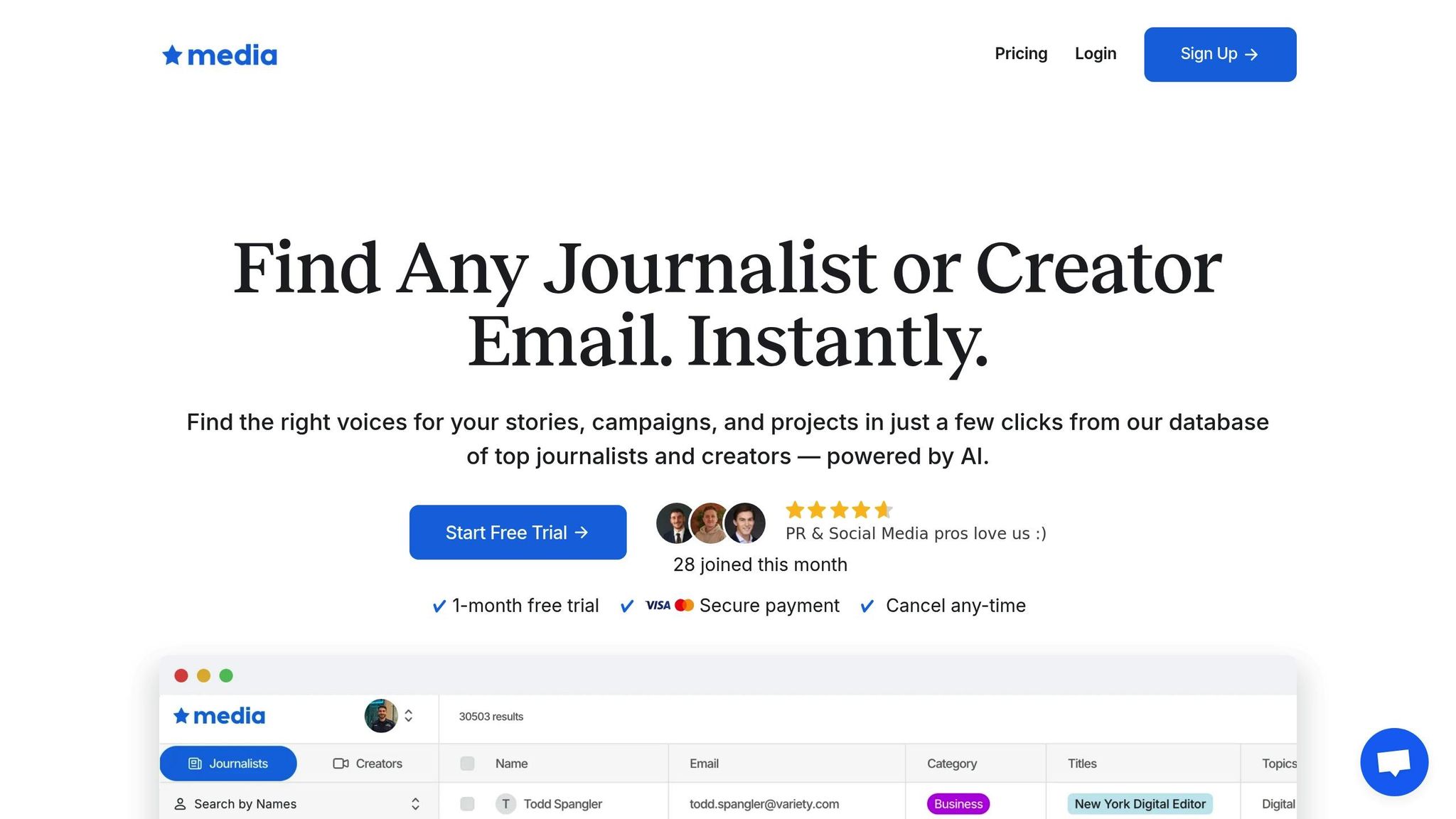How AI Ensures Brand Voice Consistency
AI tools enhance brand voice consistency by analyzing tone, automating content creation, and providing real-time feedback for diverse audiences.

Maintaining a consistent brand voice across platforms and campaigns is a major challenge, especially when multiple teams, creators, or influencers are involved. AI tools are now solving this by:
- Analyzing tone and style: AI uses Natural Language Processing (NLP) to ensure every piece of content aligns with your brand's voice, whether formal for press releases or casual for social media.
- Automating content creation: AI-powered tools generate drafts based on brand guidelines, reducing the need for extensive revisions and ensuring consistency across channels.
- Providing real-time feedback: Platforms like Grammarly and Copy.ai deliver instant suggestions to creators, saving time and improving quality during the content creation process.
- Scaling campaigns effectively: AI simplifies managing dozens of creators or influencers, ensuring all content reflects your brand identity, no matter the platform or audience.
How To Train AI With Good vs Bad Examples of Your Brand Voice?
Common Problems with Brand Voice Consistency
Keeping your brand voice consistent across PR and influencer campaigns can feel like an uphill battle, especially as teams grow and audiences diversify. Let’s dive into some common challenges that often derail efforts to maintain a unified voice.
Problems with Manual Content Review
Relying on human oversight alone has its limits. PR teams often juggle a mountain of content every day, and ensuring brand voice consistency across all of it can be overwhelming. The sheer volume makes it easy for things to slip through the cracks.
Another issue? Subjectivity. When multiple reviewers are involved, each person’s interpretation of the brand voice can vary. Tight deadlines only add to the problem. Reviewers often prioritize factual accuracy and legal compliance, leaving brand tone as an afterthought. The result? Content that might check all the technical boxes but feels disconnected from your established voice.
Manual reviews also struggle to handle context shifts. For example, your tone might need to be formal in a press release for The Wall Street Journal but casual and playful in an Instagram post. Keeping track of these nuances across different platforms and audiences can lead to fatigue, mistakes, and - ultimately - inconsistencies.
Difficulties When Scaling Campaigns
Scaling campaigns brings a whole new set of challenges. The bigger the campaign, the harder it becomes to maintain control.
If you’re working with just one influencer, it’s manageable to ensure they understand your brand voice. But what happens when you’re collaborating with 50 creators across multiple platforms? Each person brings their own writing style, and regional differences in communication can further fragment your messaging.
For example, even within the U.S., regional differences can impact how messages are received. Without a deep understanding of local preferences, your brand voice might fail to resonate - or worse, come across as tone-deaf.
Then there’s the approval process. What works for small campaigns often falls apart when scaled. Centralized review systems can’t keep up with hundreds of pieces of content. By the time feedback gets back to creators and changes are made, you’ve already missed key opportunities to engage your audience.
Reaching Different U.S. Audiences
The U.S. is a melting pot of generations, cultures, and communities, and reaching these diverse audiences without losing your brand’s identity is no small feat.
Generational differences present a tricky balancing act. For instance, the tone that resonates with Gen Z on TikTok might feel out of place when speaking to Baby Boomers through more traditional media. Many brands struggle to bridge this gap, either alienating younger audiences with overly stiff language or confusing older ones with casual slang.
Cultural nuances add another layer of complexity. The U.S. is home to a wide variety of communities, each with unique communication preferences. What feels inclusive to one group might unintentionally alienate another. Teams without diverse perspectives or cultural expertise often miss these subtleties, leading to tone-deaf messaging.
On top of that, each platform demands slight adjustments to your voice. TikTok, Instagram, LinkedIn - they all require different tones, but they still need to feel like they come from the same brand. Juggling these adjustments while staying true to your core identity is a time-consuming challenge.
When these issues aren’t addressed, the result is fragmented messaging. Instead of creating a strong, unified brand presence, you end up with mixed signals that confuse your audience and weaken trust. Instead of one cohesive brand, you’re left with competing personalities that dilute your impact.
How AI Improves Brand Voice Consistency
Keeping a brand's voice consistent is no small feat, especially when relying on manual processes. AI steps in to simplify and streamline this challenge, ensuring your brand's voice remains steady across all platforms.
Natural Language Processing for Tone and Style
Natural Language Processing (NLP) acts as a tireless guardian of your brand's voice. It examines word choices and sentence structures to identify and maintain your brand's unique tone.
Unlike human reviewers, who may interpret tone differently depending on their mood or workload, NLP delivers consistent, unbiased analysis. For example, if your brand voice leans conversational but a piece of content starts sounding overly formal, NLP will flag it. This ensures that even subtle shifts in tone - ones that might escape a seasoned editor - are caught and corrected.
NLP also understands context. It knows when casual language fits a social media post and when a more polished tone is necessary for a press release. This contextual awareness helps your brand stay authentic while adapting its tone to suit different platforms.
Another strength of NLP is its ability to handle large volumes of content. While a human might miss slight inconsistencies after reviewing dozens of pieces, AI applies the same level of scrutiny to every single one. Beyond just identifying issues, it can also help create content that aligns with your brand's voice.
Automated Content Creation with Brand Guidelines
AI-powered content creation tools have come a long way. They now craft original content that aligns with your brand’s identity from the very first draft.
These tools analyze your existing content - campaigns, press releases, social media posts - to learn not just what you say, but how you say it. They pick up on your preferred sentence structures, vocabulary, and even the rhythm of your writing.
Platforms like Copy.ai and Writer allow users to upload brand style guides and voice charts. These tools can review content and suggest adjustments to make it more consistent with your brand.
By generating drafts that already align with your brand guidelines, AI reduces the need for extensive revisions. This cuts down the back-and-forth that often slows down the content creation process.
AI also adapts seamlessly to different content types. It knows that a LinkedIn post requires a different tone than a TikTok caption, but both should still feel like they come from the same brand. This adaptability eliminates guesswork for creators and speeds up campaign launches.
On top of content creation, AI also plays a key role in quality assurance.
Real-Time Feedback and Quality Control
AI transforms workflows by offering instant feedback during content creation. Instead of waiting for human review, creators receive guidance as they write.
For instance, Grammarly’s premium version learns individual preferences and brand voice over time. It provides real-time suggestions on tone and style, helping creators stay consistent with their brand voice.
This immediate feedback addresses delays caused by traditional review cycles. AI acts as a built-in quality control system, checking every piece of content against your brand standards while it's being written. It flags deviations and inconsistencies on the spot, ensuring issues are resolved before publication.
AI operates independently, requiring no constant supervision. It works across multiple channels at once, maintaining brand voice consistency while your team focuses on strategy and creativity.
By providing real-time guidance, AI not only improves workflows but also helps team members internalize your brand voice more effectively.
Together, these AI capabilities create a powerful system for maintaining brand voice consistency. The goal isn’t to replace human creativity but to enhance it, ensuring every piece of content feels authentically yours - no matter who writes it or where it’s shared.
How to Use AI for Brand Voice Consistency
Using AI to maintain a consistent brand voice starts with a strong foundation. It’s all about setting clear guidelines and thoughtfully incorporating AI tools into your existing processes. By defining your brand’s voice and training AI with well-chosen examples, you can seamlessly integrate these tools into your workflow.
Create Clear Brand Voice Guidelines
Think of your brand voice guidelines as the playbook for AI. Start by identifying three to five key personality traits that reflect your brand’s identity. For each trait, provide a detailed explanation and examples. For instance, if your brand aims to sound approachable, show how this is conveyed - perhaps through the use of contractions or simple, conversational language.
Include examples of what your brand voice is and isn’t. If your brand avoids corporate jargon, spell out which buzzwords to leave out and suggest better alternatives. This helps AI tools understand the dos and don’ts of your brand’s tone.
Also, document how your tone should vary across platforms. AI tools need this context to adapt your voice for different channels. For example, your social media voice might be more casual, while press releases might require a more formal tone.
Don’t overlook grammar and vocabulary preferences. Do you use the Oxford comma? Do you address readers as "you" instead of "one"? These details may seem minor but are crucial for maintaining a consistent voice.
Lastly, include your unique selling points and audience pain points in the guidelines. This ensures AI generates content that not only aligns with your brand but also resonates with your target audience.
Train AI Tools with Your Brand Examples
AI tools excel when they have rich examples to learn from. The more high-quality content you provide, the better they’ll become at mimicking your brand’s style.
Gather your top-performing content from all channels - social media posts, email campaigns, blog articles, and more. Focus on pieces that truly capture your brand’s voice and have connected well with your audience. Quality matters more than quantity here.
Upload these examples to your AI platform so it can analyze your word choices, sentence structures, and overall messaging style. Many tools can even pick up on recurring themes and the rhythm of your writing.
Test the AI’s understanding by having it generate sample content. Compare its output to your brand standards. If it doesn’t hit the mark, refine the training data or provide additional examples. This trial-and-error process helps fine-tune the AI’s grasp of your voice.
You might also want to create different training sets for various content types. For instance, a press release training set could focus on professionalism, while social media examples might emphasize engagement and personality.
Keep in mind that training isn’t a one-and-done process. As your brand evolves or enters new markets, update your examples to reflect these changes. Providing fresh content ensures the AI stays aligned with your brand’s growth.
Add AI Tools to Your Content Workflow
Integrating AI into your workflow is where everything comes together. Start by identifying areas where consistency is a challenge - maybe it’s social media posts created by multiple team members or press releases across product lines.
Introduce AI at key points in your content creation process. Don’t just use it as a final review tool; involve it throughout the workflow. For example, AI can review drafts, offer suggestions during editing, and perform final checks for tone and style before publication.
Train your team to interpret and act on AI feedback. Human oversight is essential for catching nuances and making the final call on AI suggestions. Establish clear rules for when to accept AI recommendations and when to rely on human judgment.
Make sure AI enhances your team’s workflow. Set up automated alerts for major deviations from your brand voice, while allowing smaller adjustments to go directly to content creators.
As you integrate AI, track its impact on productivity and content quality. Monitor metrics like time spent on revisions, consistency scores, and team satisfaction. Use this data to fine-tune your AI setup and address any gaps.
Start small, measure the results, and expand gradually. This phased approach helps your team adapt to AI tools while preserving the authenticity that defines your brand voice.
Using Media AI for PR and Influencer Campaigns

Once you've established your AI-driven brand voice, the next step is finding journalists and creators who can genuinely represent your brand. This is where tools like Media AI become invaluable, helping you maintain consistent messaging across your PR and influencer marketing efforts.
Relying on manual media searches often leads to scattered outreach and inconsistent messaging. Media AI bridges this gap by connecting your AI-driven content with partners who naturally align with your brand's tone.
Key Features of Media AI
Media AI offers access to a curated database of over 30,000 journalists and creators, chosen for their expertise and credibility. Its AI-powered crawler ensures contact information stays up-to-date, so your outreach remains relevant. With advanced filters and export options, you can quickly create targeted media lists that align with your brand's goals.
In addition to its extensive contact database, Media AI simplifies budget management with straightforward, competitive pricing. Plans include:
- Journalist Database: $99 per month
- Creators Database: $99 per month
- Full Database: $149 per month
Each plan provides full database access, advanced filtering options, seamless exporting, and requires no long-term commitment. This flexibility allows you to confidently invest in partnerships that strengthen your brand's consistent voice.
How Media AI Supports Brand Voice Consistency
Just as AI ensures your content maintains a consistent tone, Media AI helps you find collaborators who naturally reflect your brand voice. Consistency in PR and influencer campaigns starts with choosing the right partners. Media AI makes this easier by allowing you to sort, filter, group, and share media contacts with your team, streamlining collaboration and outreach. Its filtering tools help identify journalists and creators whose style already aligns with your brand, so you can partner with individuals who complement your established voice - no guesswork required.
When building media contact lists, prioritize factors like engagement rates, audience demographics, and alignment with your brand values over follower counts. Media AI’s detailed profiles provide these insights, helping you form meaningful, authentic partnerships. Additionally, if multiple team members are involved in your PR strategy, sharing curated contact lists ensures everyone stays on the same page. By organizing contacts around specific goals, Media AI helps reinforce a unified brand voice throughout your outreach efforts.
Measuring and Improving Brand Voice Consistency with AI
AI-powered analytics take real-time feedback a step further by helping you monitor and fine-tune your brand voice consistency. Using machine learning and natural language processing (NLP), AI tools analyze influencer content for tone, sentiment, and language patterns. This detailed evaluation ensures your messaging aligns with brand guidelines while pinpointing areas that might need adjustment. With these insights, you can quickly refine your communication strategy to maintain a unified voice across all campaigns.
Updating AI Models Based on Performance
As your brand grows and campaigns generate fresh data, keeping your AI models updated is crucial for staying accurate. Performance metrics shed light on which elements of your brand voice connect most effectively with your audience, enabling you to refine guidelines and improve AI training.
Keep an eye on engagement rates, sentiment scores, and audience feedback across various types of content. If certain messaging styles consistently outperform others, use those insights to enhance your AI training data. This creates a feedback loop where successful strategies strengthen your AI's ability to deliver consistent messaging.
Regular updates also help your AI adapt to changing trends and communication styles. What resonated with audiences six months ago might feel outdated today, especially on fast-evolving platforms like social media. By revisiting and updating your AI models every quarter, you can ensure your brand voice stays relevant while preserving its core identity.
Track metrics like tone consistency scores, sentiment alignment, and deviation alerts throughout your campaigns. These data points uncover patterns and guide strategic updates to both your brand guidelines and AI configurations, keeping your messaging sharp and aligned with your brand's vision.
Conclusion: AI's Role in Modern PR and Marketing
AI has reshaped how PR professionals and marketers ensure brand voice consistency. The days of manual reviews are behind us. Today, advanced AI tools take on the bulk of the work, offering real-time insights to keep campaigns in line with brand guidelines.
One of AI's greatest strengths is its ability to scale. While a small team might manage a few influencers, AI empowers brands to maintain the same level of control across hundreds - or even thousands - of content creators. This becomes especially important when reaching diverse audiences across the U.S., where messaging must adapt to regional nuances while staying true to the brand's core identity. This scalability also plays a critical role in selecting the right media partners.
Take Media AI as an example. With a database of over 30,000 journalists and creators, it simplifies contact discovery while ensuring consistent messaging. For $149, users gain full access to a platform designed to manage complex influencer and media relationships without locking into long-term contracts - a practical solution for PR professionals and agencies.
But the benefits of AI go beyond maintaining consistency. It saves time, reduces costs, and drives better campaign results. By automating tasks like quality control and performance tracking, AI allows teams to focus on strategic planning and creative execution.
For those in PR and marketing who haven’t yet embraced AI, the real question is no longer "if" but "how soon." Brands already using AI to maintain brand voice consistency are raising the bar for messaging quality and campaign success. Those sticking to manual processes risk being left behind in a fast-paced market where every message counts. Adopting AI isn’t just an option - it’s a necessity to thrive in today’s competitive landscape.
FAQs
How does AI help maintain a consistent brand voice across platforms?
AI uses Natural Language Processing (NLP) to dive into your brand's current content, examining details like word choice, tone, and sentence flow. By creating a detailed blueprint of your brand's voice, it can craft new content that aligns perfectly with your established style.
This means your messaging stays consistent across platforms - whether it's social media, your website, or marketing campaigns - strengthening audience trust and making your brand easily recognizable.
How can AI tools help streamline content creation while maintaining a consistent brand voice?
AI tools can make content creation easier and help maintain a consistent brand voice by taking over repetitive tasks and analyzing how well your content matches your brand's guidelines. To get started, pinpoint the areas where AI can make a difference - like brainstorming content ideas, fine-tuning your tone, or ensuring your messaging stays uniform across all platforms.
When selecting AI tools, focus on those that meet your specific goals, whether that's managing your brand voice or optimizing content performance. Make sure your team is trained to use these tools effectively, and set up clear workflows to seamlessly incorporate them into your current processes. Keep an eye on the system, reviewing and tweaking it regularly, so it continues to meet quality standards and grows alongside your brand's objectives.
How does AI help ensure consistent brand messaging when selecting media partners for PR and influencer campaigns?
AI makes it easier to connect with the right media partners by analyzing data to pinpoint creators whose audience, tone, and content style align with your brand’s message and objectives. This approach helps maintain a consistent and unified brand voice in every collaboration.
With AI-powered tools, you can sift through massive amounts of content, use predictive analytics, and find creators who genuinely reflect your brand’s values. By automating these processes, AI simplifies campaign planning and ensures your messaging stays aligned across all platforms.





